Development of Priority Index for Intelligent Vessel Traffic Monitoring System in Vessel Traffic Service Areas
Abstract
1. Introduction
2. Materials and Methods
2.1. Review of VTS Operation
- Simultaneous events: The situation changes every moment owing to the nature of shipbuilding, and the intention of the shipbuilder must be understood. Several ships may be simultaneously placed in the same situation, in different places, or under different circumstances.
- Time pressure: Decisions must be made within a limited time and prompt processing of work is required.
- Processing of large amounts of information: Information on the current situation in the VTS area and related historical information are required.
- Accurate processing of information: An error in the information received or transmitted from a vessel is directly linked to the risk of a marine accident.
- Pressure to solve a problem: There is constant psychological pressure to solve a particular situation.
- Pressure to make a decision: In addition to the decision making for the vessel, other decisions such as verification and support should be made.
- High traffic density
- Traffic carrying hazardous cargoes
- Conflicting and complex navigation patterns
- Difficult hydrographical, hydrological, and meteorological elements
- Shifting shoals and other local hazards
- Environmental considerations
- Interference by vessel traffic with other marine-based activities
- A record of maritime casualties
- Existing or planned vessel traffic services in adjacent waters and the need for cooperation between neighboring states if appropriate
- Narrow channels, port configuration, bridges, and similar areas where vessel progress may be restricted
- Existing or foreseeable changes in traffic patterns resulting from port or offshore terminal development or offshore exploration and exploitation in the area.
2.2. Data Processing Sequence
2.3. Data Pre-Processing
2.4. Data Clustering
2.5. Fuzzy Logic
3. Results
4. Conclusions
Author Contributions
Funding
Institutional Review Board Statement
Informed Consent Statement
Acknowledgments
Conflicts of Interest
Appendix A
| ID | Epsilon | 0.010 | 0.015 | 0.020 | |||
|---|---|---|---|---|---|---|---|
| MinPts | 5 | 10 | 5 | 10 | 5 | 10 | |
| Noise | 120 | 277 | 47 | 189 | 30 | 110 | |
| Cluster ID 1 | 10 | 213 | 10 | 10 | 18 | 17 | |
| Cluster ID 2 | 236 | 12 | 291 | 249 | 461 | 298 | |
| Cluster ID 3 | 9 | 18 | 7 | 29 | 17 | 61 | |
| Cluster ID 4 | 27 | 11 | 59 | 56 | 15 | 41 | |
| Cluster ID 5 | 9 | 10 | 30 | 14 | 14 | 14 | |
| Cluster ID 6 | 5 | 14 | 16 | 12 | 10 | 14 | |
| Cluster ID 7 | 46 | 12 | 6 | 17 | 11 | 11 | |
| Cluster ID 8 | 12 | 9 | 25 | - | - | 10 | |
| Cluster ID 9 | 7 | - | 14 | - | - | - | |
| Cluster ID 10 | 5 | - | 17 | - | - | - | |
| Cluster ID 11 | 11 | - | 13 | - | - | - | |
| Cluster ID 12 | 5 | - | 6 | - | - | - | |
| Cluster ID 13 | 7 | - | 7 | - | - | - | |
| Cluster ID 14 | 5 | - | 11 | - | - | - | |
| Cluster ID 15 | 9 | - | 7 | - | - | - | |
| Cluster ID 16 | 5 | - | 5 | - | - | - | |
| Cluster ID 17 | 6 | - | 5 | - | - | - | |
| Cluster ID 18 | 6 | - | - | - | - | - | |
| Cluster ID 19 | 5 | - | - | - | - | - | |
| Cluster ID 20 | 5 | - | - | - | - | - | |
| Cluster ID 21 | 6 | - | - | - | - | - | |
| Cluster ID 22 | 15 | - | - | - | - | - | |
| Cluster ID 23 | 5 | - | - | - | - | - | |
| Total | 576 | 576 | 576 | 576 | 576 | 576 | |
References
- Marzano, V.; Tocchi, D.; Fiori, C.; Tinessa, F.; Simonelli, F.; Cascetta, E. Ro-Ro/Ro-Pax maritime transport in Italy: A policy-oriented market analysis. Case Stud. Transp. Policy 2020, 8, 1201–1211. [Google Scholar] [CrossRef]
- Simonelli, F.; Tinessa, F.; Marzano, V.; Papola, A.; Romano, A. Laboratory experiments to assess the reliability of traffic assignment map. In Proceedings of the 2019 6th International Conference on Models and Technologies for Intelligent Transportation Systems (MT-ITS), Cracow, Poland, 5–7 June 2019; pp. 1–9. [Google Scholar] [CrossRef]
- Korean Maritime Safety Tribunal. Status of Marine Accidents. Available online: https://www.kmst.go.kr/kmst/statistics/annualReport/selectAnnualReportList.do (accessed on 3 August 2021).
- International Association of Marine Aids to Navigation and Lighthouse Authorities. IALA Recommendation V-127 VTS Operations; IALA: Saint-Germain-en-Laye, France, 2018. [Google Scholar]
- Kim, J.-S.; Jeong, J.-S.; Park, G.-K. Utilization of planned routes and dead reckoning positions to improve situation awareness at sea. Int. J. Fuzzy Log. Intell. Syst. 2014, 14, 288–294. [Google Scholar] [CrossRef]
- Kim, J.-S. A Design of Reference Route Model Based on SVR through Reconstruction of Ship Trajectories in VTS Area. Ph.D. Thesis, Mokpo National Maritime University, Mokpo, Korea, 2016. [Google Scholar]
- Fujii, Y.; Tanaka, K. Studies in marine traffic engineering: Traffic capacity. J. Navig. 1971, 24, 543–552. [Google Scholar] [CrossRef]
- Coldwell, T. Marine traffic behaviour in restricted waters. J. Navig. 1983, 36, 430–444. [Google Scholar] [CrossRef]
- Im, N.; Luong, T.N. Potential Risk Ship Domain as a Danger Criterion for Real-Time Ship Collision Risk Evaluation. Ocean Eng. 2019, 194, 106610. [Google Scholar] [CrossRef]
- Ożoga, B.; Montewka, J. Towards a Decision Support System for Maritime Navigation on Heavily Trafficked Basins. Ocean Eng. 2018, 159, 88–97. [Google Scholar] [CrossRef]
- Ahn, J.-H.; Rhee, K.-P.; You, Y.-J. A Study on the Collision Avoidance of a Ship using Neural Networks and Fuzzy Logic. Appl. Ocean Res. 2012, 37, 162–173. [Google Scholar] [CrossRef]
- International Maritime Organization. International Convention for the Safety of Life at Sea 1974 Amended 2020; International Maritime Organization: London, UK, 2020.
- International Maritime Organization. Guidelines for Vessel Traffic Services, IMO Resolution A. 857 (20); International Maritime Organization: London, UK, 1997.
- Lee, E.; Huh, Y.-B.; Kim, J.-O.; Park, S.-T.; An, G.; Yun, J.-S.; Jeong, G.-N.; Hong, S.-B. Vessel Traffic System, 1st ed.; Joongangseorim: Busan, Korea, 2005. [Google Scholar]
- Kim, J.-S.; Jeong, J.-S.; Park, G.-K. Prediction Table for Marine Traffic for Vessel Traffic Service based on Cognitive Work Analysis. Int. J. Fuzzy Log. Intell. Syst. 2013, 13, 315–323. [Google Scholar] [CrossRef]
- Bowditch, N. The American Practical Navigator: Being an Epitome of Navigation and Nautical Astronomy; Nabu Press: Charleston, SC, USA, 2013. [Google Scholar]
- Gang, L.; Wang, Y.; Sun, Y.; Zhou, L.; Zhang, M. Estimation of Vessel Collision Risk Index based on Support Vector Machine. Adv. Mech. Eng. 2016, 8, 1–10. [Google Scholar] [CrossRef]
- Benjamin, M.R.; Leonard, J.J.; Curcio, J.A.; Newman, P.A. Method for Protocol-Based Collision Avoidance between Autonomous Marine Surface Craft. J. Field Robot. 2006, 23, 333–346. [Google Scholar] [CrossRef]
- International Association of Marine Aids to Navigation and Lighthouse Authorities. IALA Guidelines 1082 an Overview of AIS; IALA: Saint-Germain-en-Laye, France, 2016. [Google Scholar]
- Ester, M.; Kriegel, H.-S.; Sander, J. A Density-Based Algorithm for Discovering Clusters in Large Spatial Databases with Noise. In Proceedings of the Second International Conference on Knowledge Discovery and Data Mining (KDD-96), Oregon, Portland, 2–4 August 1996; pp. 226–231. [Google Scholar]
- Lei, B. A DBSCAN based Algorithm for Ship Spot Area Detection in AIS Trajectory Data. MATEC Web Conf. 2019, 291, 01008. [Google Scholar] [CrossRef][Green Version]
- Lee, H.-T.; Lee, J.-S.; Yang, H.; Cho, I.-S. An AIS Data-Driven Approach to Analyze the Pattern of Ship Trajectories in Ports Using the DBSCAN Algorithm. Appl. Sci. 2021, 11, 799. [Google Scholar] [CrossRef]
- Han, X.; Armenakis, C.; Jadidi, M. Modeling Vessel Behaviours by Clustering AIS Data Using Optimized DBSCAN. Sustainability 2021, 13, 8162. [Google Scholar] [CrossRef]
- Mieczyńska, M.; Czarnowski, I. DBSCAN algorithm for AIS data reconstruction. Procedia Comput. Sci. 2021, 192, 2512–2521. [Google Scholar] [CrossRef]
- Wang, Z.; Yao, M.; Meng, C.; Claramunt, C. Risk Assessment of the Overseas Imported COVID-19 of Ocean-Going Ships Based on AIS and Infection Data. ISPRS Int. J. Geo-Inf. 2020, 9, 351. [Google Scholar] [CrossRef]
- Giacoumidis, E.; Lin, Y.; Jarajreh, M.; O’Duill, S.; McGuinness, K.; Whelan, P.F.; Barry, L.P. A Blind Nonlinearity Compensator Using DBSCAN Clustering for Coherent Optical Transmission Systems. Appl. Sci. 2019, 9, 4398. [Google Scholar] [CrossRef]
- Lee, L.-N.; Namgung, H.; Kim, J.-S.; Lee, J.-S. Development of Priority Index for Intelligent Vessel Monitoring System in Vessel Traffic Service Areas. In Proceedings of the 22nd International Symposium on Advanced Intelligent Systems, Cheongju, Korea, 15–18 December 2021; p. OS07-4. [Google Scholar]
- Yen, J.; Langari, R. Fuzzy Logic: Intelligence, Control, and Information, 1st ed.; Prentice-Hall: Upper Saddle, NJ, USA, 1999. [Google Scholar]
- Tsoukalas, L.H.; Uhrig, R.E. Fuzzy and Neural Approaches in Engineering, 1st ed.; Wiley: Hoboken, NJ, USA, 1997. [Google Scholar]
- Cockcroft, A.N.; Lameijer, J.N.F. A Guide to the Collision Avoidance Rules, 7th ed.; Butterworth Heinemann: Oxford, UK, 2011. [Google Scholar]
- Namgung, H.; Kim, J.-S. Collision Risk Inference System for Maritime Autonomous Surface Ships Using COLREGs Rules Compliant Collision Avoidance. IEEE Access 2021, 9, 7823–7835. [Google Scholar] [CrossRef]
- Hasekawa, K.; Kouzyki, A.; Muramatsu, T.; Komine, H.; Watabe, Y. Ship Auto-navigation Fuzzy Expert System (SAFES). J. Soc. Nav. Arch. Jpn. 1989, 166, 445–452. [Google Scholar] [CrossRef]
- Lee, H.-J.; Rhee, K.-P. Development of Collision Avoidance System by using Expert System and Search Algorithm. Int. Shipbuild. Prog. 2001, 48, 197–212. [Google Scholar]
- Jang, J.R. Adaptive-network based fuzzy inference system. IEEE Trans. Syst. Man Cybern. Syst. 1993, 23, 665–685. [Google Scholar] [CrossRef]
- IMO. International Regulations for Preventing Collisions at Sea, COLREGs; International Maritime Organization: London, UK, 1972.
- Korea Hydrographic and Oceanographic Agency. West Coast of Korea Pilot; Hydrographic and Oceanographic Agency: Busan, Korea, 2020. [Google Scholar]
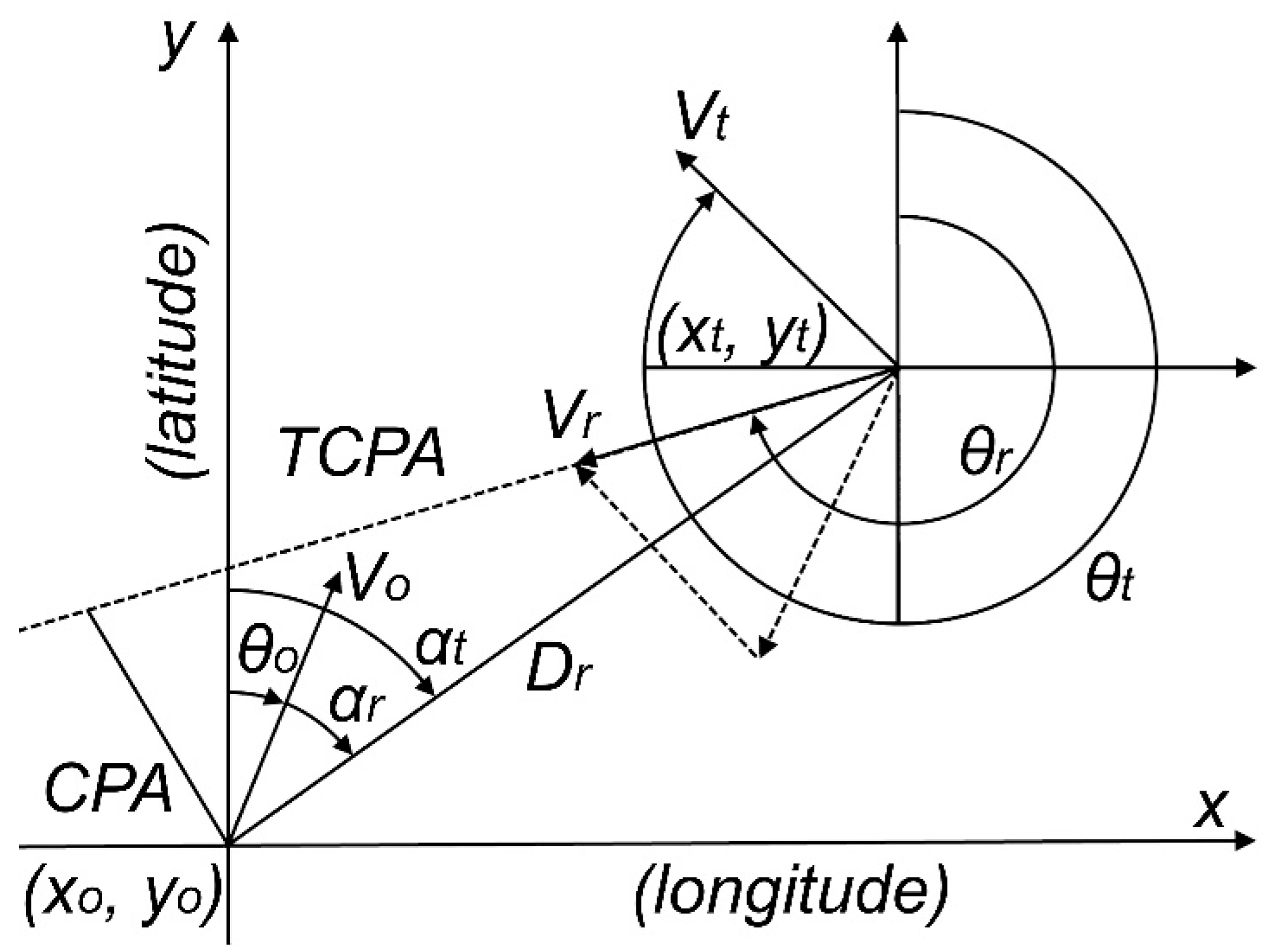


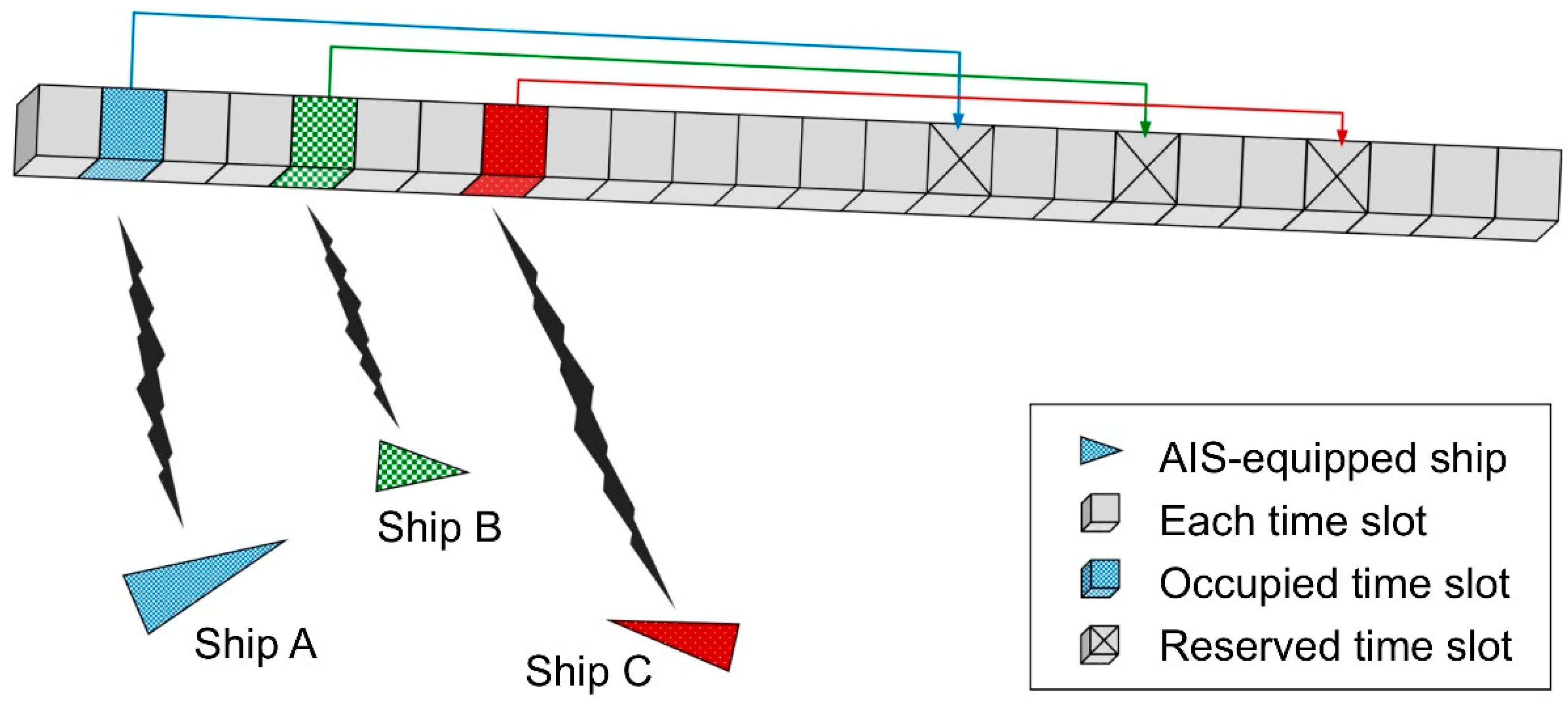
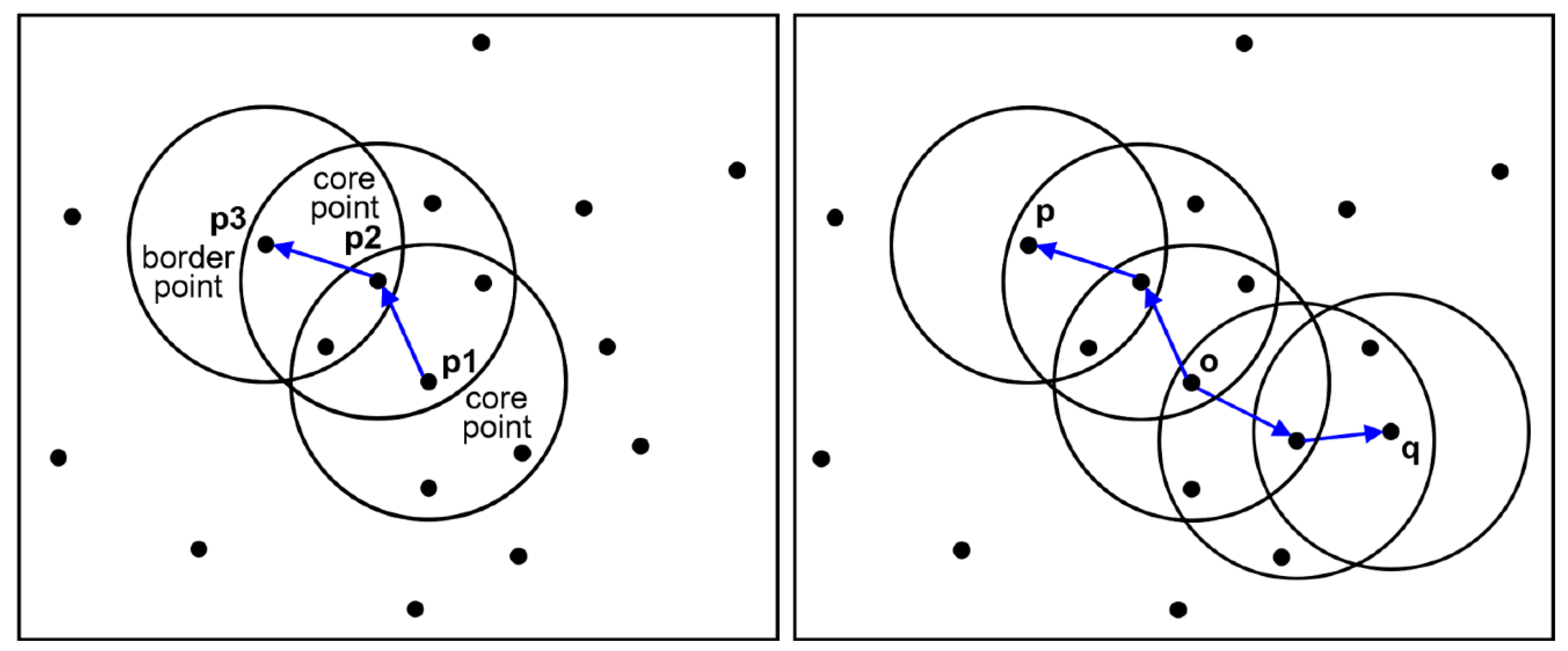
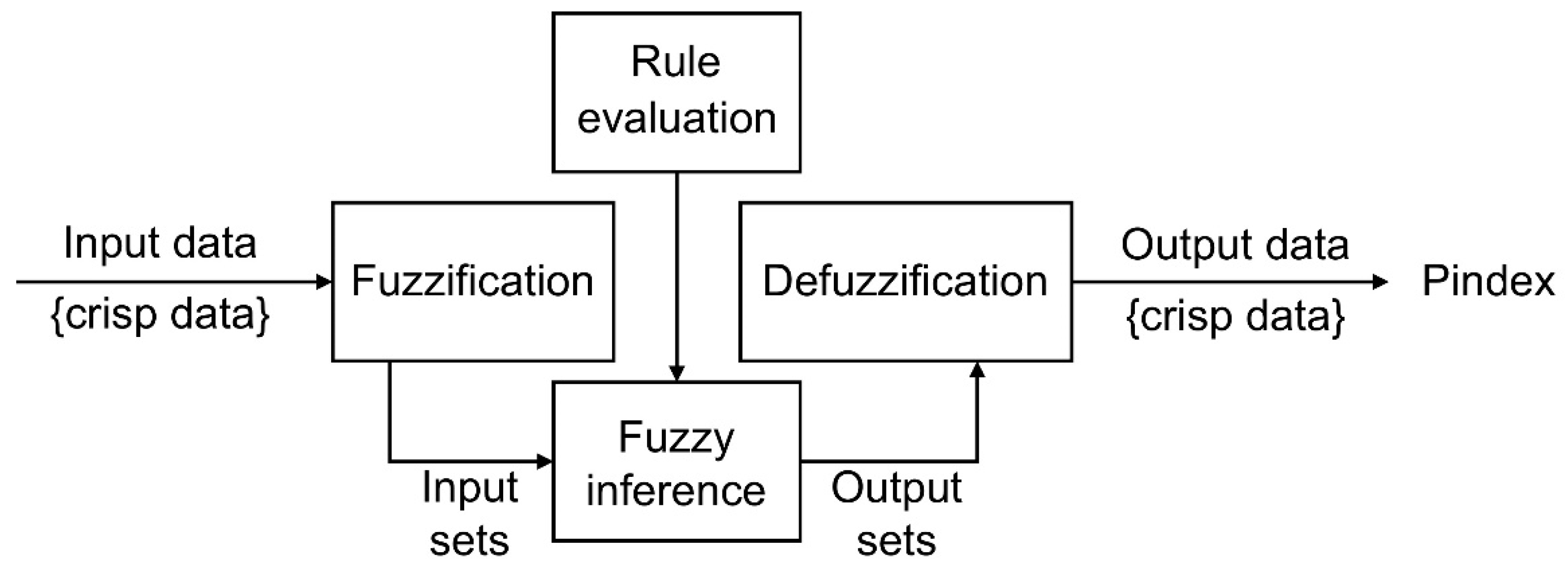
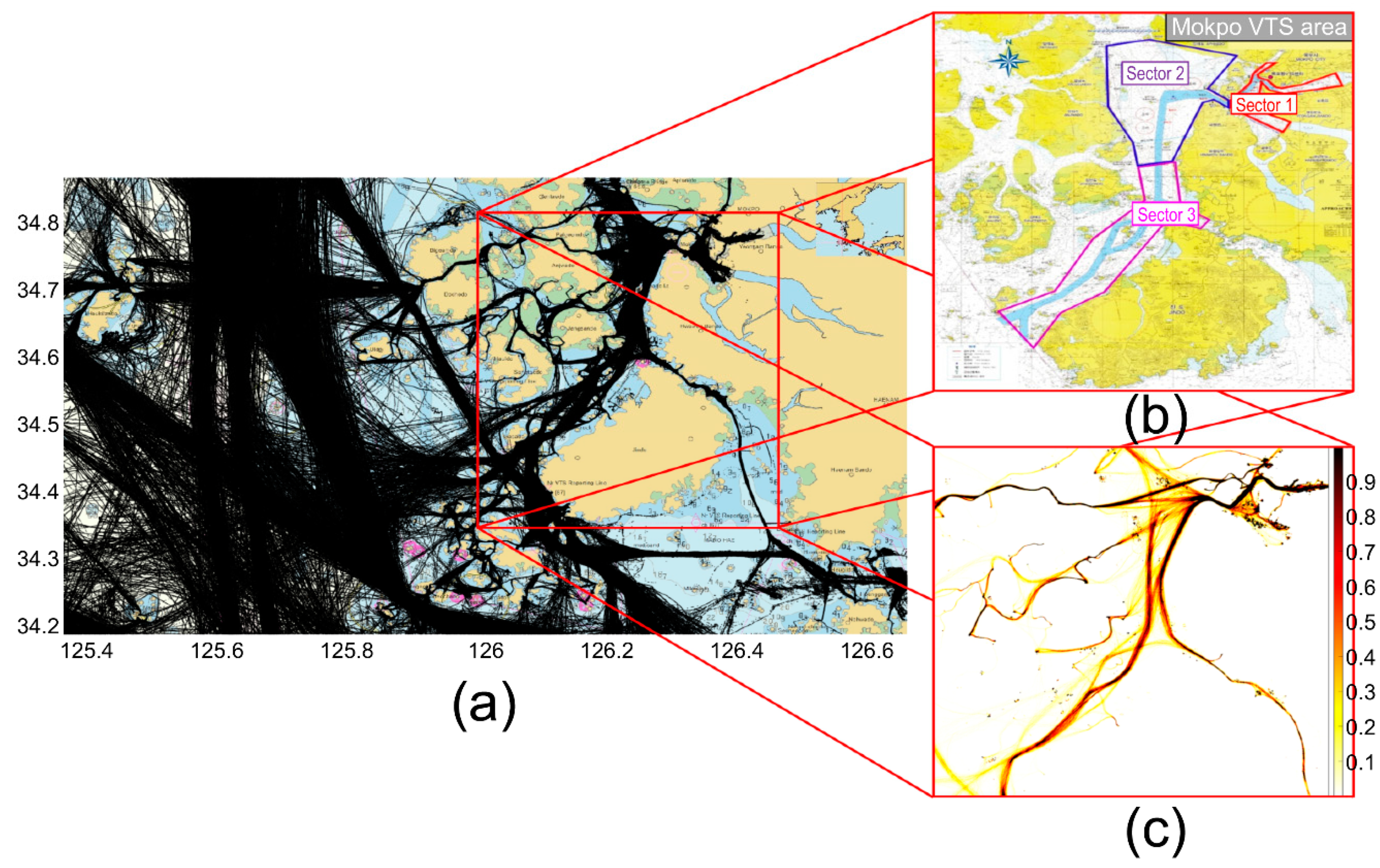

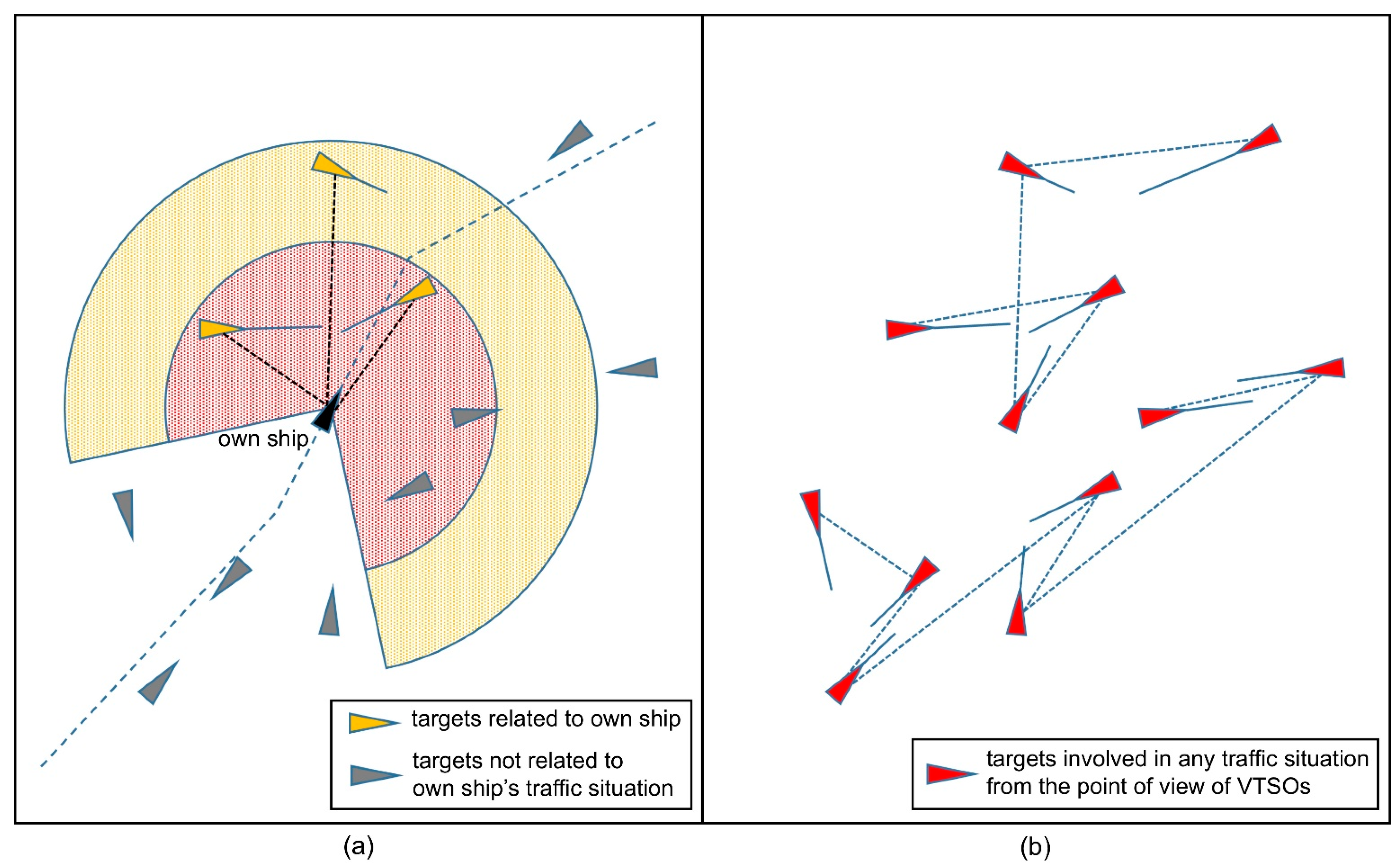
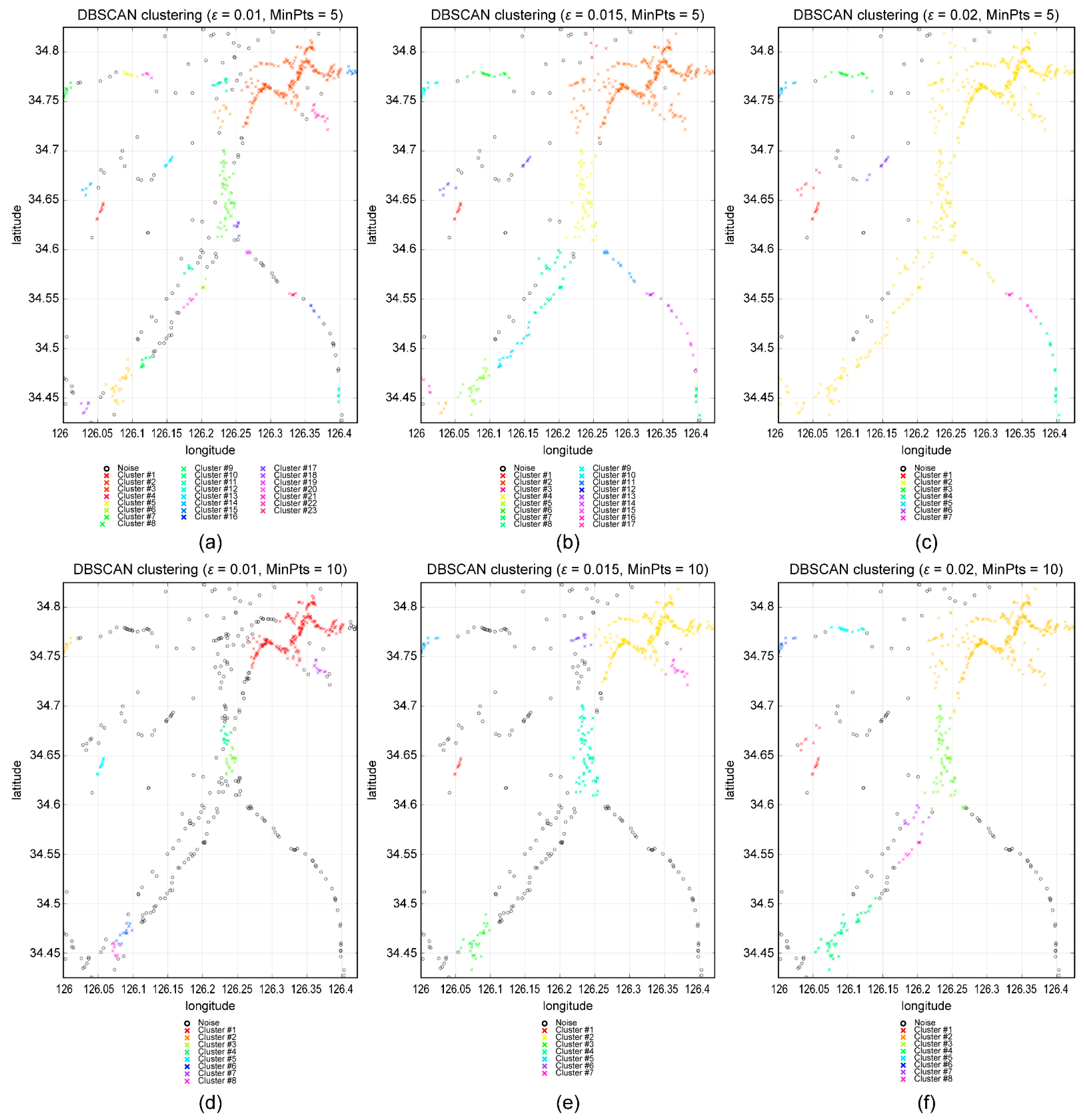

| Station Type | Nominal Interval |
|---|---|
| AIS Class B speed < 2 knots | 3 min |
| AIS Class A speed < 3 knots in ‘At anchor’ or ‘Moored’ status | 3 min |
| AIS Class B speed > 2 knots | 30 s |
| AIS Class A speed > 3 knots in ‘At anchor’ or ‘Moored’ status | 10 s |
| AIS Class A speed 0–14 knots | 10 s |
| AIS Class A speed 0–14 knots and changing course | 3 1/3 s |
| AIS Class B speed 14–23 knots | 15 s |
| AIS Class A speed 14–23 knots | 6 s |
| AIS Class B speed > 23 knots | 5 s |
| AIS Class A speed 14–23 knots and changing course, or speed > 23 knots | 2 s |
| Search And Rescue Aircraft (airborne mobile equipment) | 10 s |
| AIS Base Station | 10 s |
| AIS AtoN | 3 min |
| Transmissions of AIS Application Specific Messages | 3 min |
| Transmissions of AIS Long-Range Reports | 6 min |
| TCPA | Level 1 (No Action Required) | Level 2 (Action Initiation Time) | Level 3 (Final Action Initiation Time) | Level 4 (No Time to React) | |
|---|---|---|---|---|---|
| CPA | |||||
| level 1 (No hazard) | Lack of collision hazard | Lack of collision hazard | Lack of collision hazard | Lack of collision hazard | |
| level 2 (Minor hazard) | Lack of collision hazard | Remote collision hazard | Remote collision hazard | Close collision hazard | |
| level 3 (Real hazard) | Lack of collision hazard | Remote collision hazard | Close collision hazard | Very Close collision hazard | |
| level 4 (Collision) | Lack of collision hazard | Close collision hazard | Very Close collision hazard | Collision imminent | |
| TCPA | Danger | Threat | Caution | Attention | |
|---|---|---|---|---|---|
| CPA | |||||
| Danger | 1.0 | 0.9 | 0.7 | 0.4 | |
| Threat | 0.9 | 0.8 | 0.6 | 0.3 | |
| Caution | 0.7 | 0.5 | 0.3 | 0.2 | |
| Attention | 0.5 | 0.3 | 0.2 | 0.1 | |
| Risk Level | CPA (Nautical Miles) | TCPA (Seconds) | |||||||
|---|---|---|---|---|---|---|---|---|---|
| Cluster ID | Danger | Threat | Caution | Attention | Danger | Threat | Caution | Attention | |
| #1 | 0.0 | 0.1352 | 0.4376 | 0.7549 | 0 | 120 | 240 | 360 | |
| #2 | 0.0 | 0.0712 | 0.7418 | 0.9997 | |||||
| #3 | 0.0 | 0.3005 | 0.7040 | 0.9494 | |||||
| #4 | 0.0 | 0.2677 | 0.7848 | 0.9996 | |||||
| #5 | 0.0 | 0.2021 | 0.7354 | 0.9892 | |||||
| #6 | 0.0 | 0.1936 | 0.6244 | 0.9618 | |||||
| #7 | 0.0 | 0.3336 | 0.6259 | 0.9182 | |||||
| #8 | 0.0 | 0.2225 | 0.6382 | 0.9822 | |||||
| #9 | 0.0 | 0.1938 | 0.6607 | 0.9861 | |||||
| #10 | 0.0 | 0.4122 | 0.6411 | 0.9445 | |||||
| #11 | 0.0 | 0.2886 | 0.4623 | 0.9004 | |||||
| #12 | 0.0 | 0.5340 | 0.7902 | 0.8500 | |||||
| #13 | 0.0 | 0.1323 | 0.5265 | 0.8603 | |||||
| #14 | 0.0 | 0.2100 | 0.4992 | 0.8359 | |||||
| #15 | 0.0 | 0.2704 | 0.8322 | 0.8679 | |||||
| #16 | 0.0 | 0.4503 | 0.6564 | 0.8625 | |||||
| #17 | 0.0 | 0.2546 | 0.6460 | 0.8664 | |||||
Publisher’s Note: MDPI stays neutral with regard to jurisdictional claims in published maps and institutional affiliations. |
© 2022 by the authors. Licensee MDPI, Basel, Switzerland. This article is an open access article distributed under the terms and conditions of the Creative Commons Attribution (CC BY) license (https://creativecommons.org/licenses/by/4.0/).
Share and Cite
Lee, L.-n.; Kim, J.-s. Development of Priority Index for Intelligent Vessel Traffic Monitoring System in Vessel Traffic Service Areas. Appl. Sci. 2022, 12, 3807. https://doi.org/10.3390/app12083807
Lee L-n, Kim J-s. Development of Priority Index for Intelligent Vessel Traffic Monitoring System in Vessel Traffic Service Areas. Applied Sciences. 2022; 12(8):3807. https://doi.org/10.3390/app12083807
Chicago/Turabian StyleLee, Lee-na, and Joo-sung Kim. 2022. "Development of Priority Index for Intelligent Vessel Traffic Monitoring System in Vessel Traffic Service Areas" Applied Sciences 12, no. 8: 3807. https://doi.org/10.3390/app12083807
APA StyleLee, L.-n., & Kim, J.-s. (2022). Development of Priority Index for Intelligent Vessel Traffic Monitoring System in Vessel Traffic Service Areas. Applied Sciences, 12(8), 3807. https://doi.org/10.3390/app12083807







